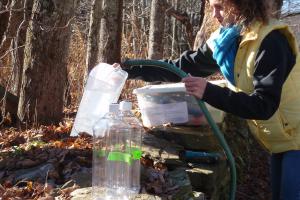Feb 16 2016
“The answer to that question is 'yes,' but not usually,” said Rob Jackson, a professor of Earth system science at Stanford University.
An expert on the health impacts of fossil-fuel extraction, Jackson has studied groundwater quality at oil and gas fields throughout the United States.

“We have found a number of homes near active wells with very high levels of natural gas in the tap water,” said Jackson, a senior fellow at the Stanford Woods Institute for the Environment and at the Precourt Institute for Energy. “Where the chemistry suggests contamination, the problem usually lies with the integrity of the well, either the cementing used to isolate it from the surrounding rock and water or the steel casing that allows gas and oil to flow upwards.”
Technician Alissa White collects drinking water near an oil and gas field in Parker County, Tx. (Photo: Rob Jackson)
Jackson presented his findings today at the annual meeting of the American Association for the Advancement of Science (AAAS) in Washington, D.C. Most documented cases of groundwater contamination were the result of poorly constructed wells, he said, pointing to a widely publicized case in Parker County, Texas.
“At that site, the company cemented very near the surface and deep underground, but they put no cement for 4,000 feet in between,” he explained. “The gap allowed gases to move up and down freely like a chimney and contaminate the drinking-water supply. Here we are five years later and we're still talking about it. That situation should have been fixed. These people have been left unprotected."
It is in the industry's best interest to address the contamination problem in Parker County, he added.
Besides structural issues, Jackson and his colleagues have identified problems associated with hydraulic fracturing, or fracking - pumping pressurized sand, water and chemicals underground to crack open rocks and release trapped reservoirs of oil and gas.
Fracking wells are often installed a mile or more below the surface, far from underground sources of drinking water. But in a recent study, Jackson found that at least 2,600 wells in U.S. have been fracked at depths shallower than 3,000 feet, some just hundreds of feet below the surface.
“We found a surprising number of places where companies are fracking directly into shallow freshwater aquifers,” he said. “In no other industry would you be allowed to inject chemicals into a source of drinking-quality water. Should it be allowed? In my opinion, 'no.'"
Jackson cited a high-profile case in Pavillion, Wyo., where the U.S. Environmental Protection Agency (EPA) found that shallow fracking operations had released natural gas and other toxic compounds into freshwater aquifers.
“At Pavillion, they were fracking less than 1,000 feet deep, while people were getting drinking water at 750 feet,” Jackson said. “Contamination is more likely to occur when there isn’t enough separation between the hydraulic fracturing activity and the drinking-water sources.”
In California, Jackson has identified hundreds of fracking wells drilled into aquifers located less than 2,000 feet below the surface. In the U.S., hydraulic fracturing is typically regulated by individual states.
“Some states, like Texas and Pennsylvania, generally have pretty strong environmental regulations,” Jackson said. “Others, like West Virginia and Arkansas, don't. Only Texas and Colorado have restrictions or additional safeguards in place for shallow hydraulic fracturing.”
The 2010 documentary, Gasland, sparked controversy with footage of a kitchen tap catching fire at a home located near a natural gas well. “That doesn’t happen often, but we have seen it,” Jackson said. “We’ve also documented people’ s water change from clean to contaminated over the course of a year.”
Natural gas consists primarily of methane, a greenhouse gas that’s more than 30 times more potent than carbon dioxide over a 100-year period. Concerns about global warming and the potential impacts if natural gas on drinking water have led several European countries to take a much more cautious approach to hydraulic fracturing, Jackson said.
“In Germany, France, and many other countries, officials are under pressure to invest in solar, wind and other renewables instead of a technology that produces greenhouse gases,” he said.
Other speakers at today's AAAS symposium included Nathan Wiser of the EPA, which collected data on 23,000 hydraulically fractured wells in 30 states in 2010. The results found more than 1,000 relatively shallow wells had no protective covering or just one casing and cement sheath. About two-thirds of all wells surveyed had uncemented portions, he added.